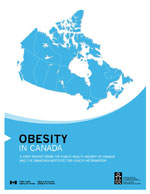Obesity in Canada
Overview
The Obesity in Canada report is a joint partnership between the Public Health Agency of Canada (PHAC) and Canadian Institute for Health Information (CIHI).
Released on June 20, 2011, this report provides:
- Obesity rates among adults, children and youth, and Aboriginal Peoples;
- New analysis of the determinants of obesity and the impacts that addressing those determinants can have on the prevalence of obesity;
- An updated estimate of the health and economic costs of obesity; and
- A summary of key lessons learned from the international literature on obesity prevention and management.
Report highlights:
- Approximately one in four Canadian adults are obese, according to measured height and weight data from 2007-2009. Of children and youth aged six to 17, 8.6% are obese.
- Between 1981 and 2007/09, obesity rates roughly doubled among both males and females in most age groups in the adult and youth categories.
- Across Canada, adult obesity rates vary from 5.3% in Richmond, BC to 35.9% in the Mamawetan/Keewatin/Athabasca region of SK.
- The economic costs of obesity are estimated at $4.6 billion in 2008, up about 19% from $3.9 billion in 2000, based on costs associated with the eight chronic diseases most consistently linked to obesity. Estimates rise to close to $7.1 billion when based on the costs associated with 18 chronic diseases linked to obesity.
- Factors that influence obesity include physical activity, diet, socioeconomic status, ethnicity, immigration, and environmental factors.
- Strategies to combat obesity and address the environments that encourage obesity fall into three main categories:
- health services and clinical interventions that target individuals;
- community-level interventions that directly influence individual and group behaviours;
- public policies that target broad social or environmental determinants.
- Like quitting smoking, effectively preventing obesity may require a multifaceted, long-term approach involving complementary interventions that operate at multiple levels.
Table of Contents
- Acknowledgements
- Abbreviations
- Executive Summary
- Introduction
- Prevalence Among Adults
- Prevalence Among Children and Youth
- Prevalence Among Aboriginal Populations
- Determinants and Contributing Factors
- Health and Economic Implications
- Opportunities for Intervention
- Appendix 1. Estimating the prevalence of obesity: methodology and additional 2007/08 CCHS analyses
- Appendix 2. Updated economic burden of obesity analysis: summary of methodology
- Appendix 3. Impact of behaviour and socioeconomic factors on the prevalence of obesity in the population: summary of methodology
- Appendix 4. Resources
- References
List of Figures
- Figure 1. Prevalence of Obesity, Ages 18 Years and Older, Canada, 1978-2009
- Figure 2. Distribution of BMI Categories by Sex, Ages 18 to 79, 2007-2009
- Figure 3. Prevalence of Self-Reported Obesity by Age and Sex, Canada, 2007/08
- Figure 4. Prevalence of Self-Reported Obesity by Province/Territory, Ages 18 and Older, 2003-2007/08
- Figure 5. Prevalence of Self-Reported Obesity, Ages 18 and Older, 2007/08: Top and Bottom Ten Ranked Health Regions
- Figure 6. Prevalence of Obesity in OECD Countries, 2004-2008
- Figure 7. Prevalence of Self-Reported Obesity by Sex, Ages 12 to 17, 2000-2007/08
- Figure 8. Prevalence of Self-reported Obesity of Aboriginal and non-Aboriginal Adults Aged 18 Years and Older by Province/Territory, Canada, 2007/08
- Figure 9. Prevalence of Self-Reported Obesity among Aboriginal Peoples by Sex and Income, Ages 18 and Older, 2006
- Figure 10. Prevalence of Self-Reported Obesity among Aboriginal Peoples by Education and Sex, Ages 18 and Older, 2006
- Figure 11. Prevalence of Self-Reported Obesity by Area-Level SES in Select Census Metropolitan Areas, 2005-2008
- Figure 12. Population Attributable Risk of Self-Reported Obesity, by Risk Factor and Sex, Ages 18 Years and Older, Canada
- Figure 13. Population Impact Number of Self-Reported Overweight and Obesity Among Males, by Risk Factor, Body Mass Index Category, Ages 18 Years and Older, Canada
- Figure 14. Population Impact Number of Self-Reported Overweight and Obesity Among Females by Risk Factor, Body Mass Index Category, Ages 18 Years and Older, Canada
- Figure 15. Estimated Annual Direct and Indirect Costs Associated with Obesity ($ billion), Adults Aged 18 and over, Canada 2000-2008
List of Tables
- Table 1. Prevalence of Measured Obesity Among Children and Youth by Age, Sex and Source
- Table 2. Prevalence of Obesity Among Aboriginal Peoples in Canada by Age and Sex, and Source
- Table 3. Sample Size Information for CCHS Cycles Used In Obesity Analyses
- Table 4. Characteristics of Sample Population and Non-respondents, CCHS 2007/08
- Table 5. Age-Standardized Obesity Estimates
- Table 6. Prevalence of Self-reported Obesity by Health Region, Ages 18 and over, 2007/08
- Table 7. Sample Size, Demographic Characteristics and Prevalence of Social Determinant and Health Behaviour Risk Factors by Sex, Canada 2000/01, 2003, 2005
